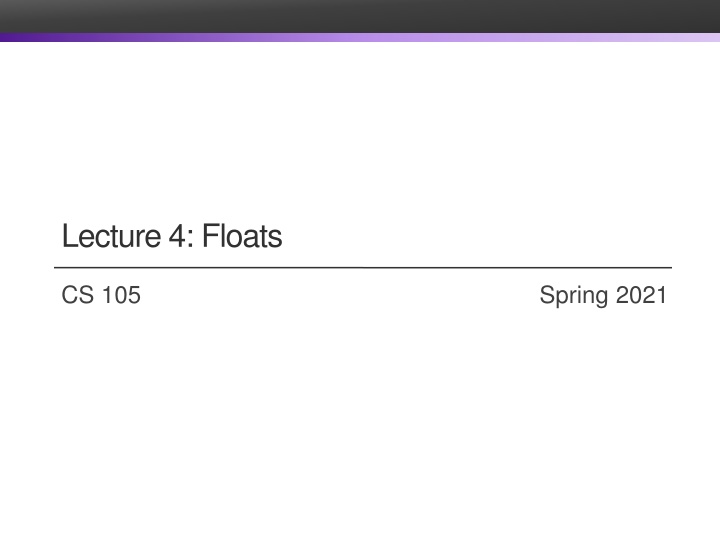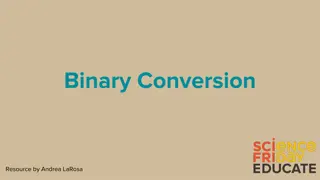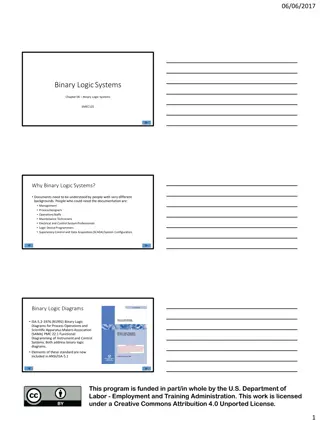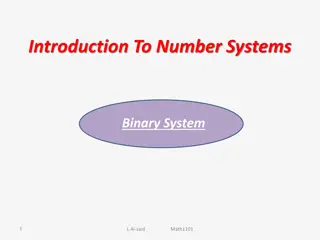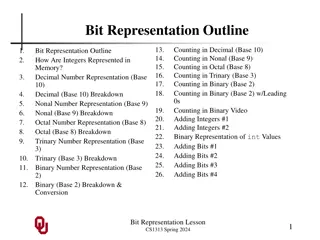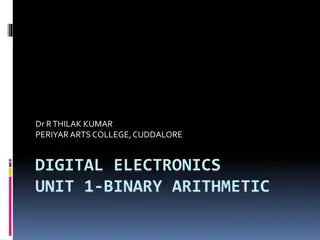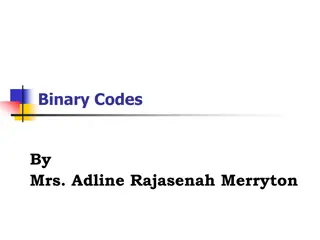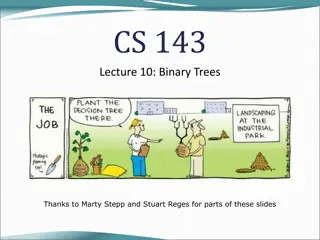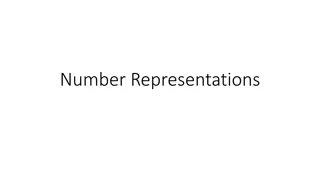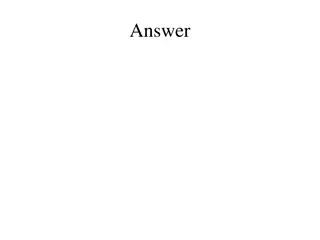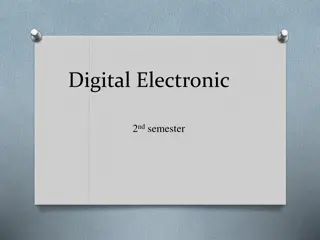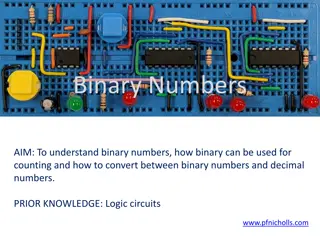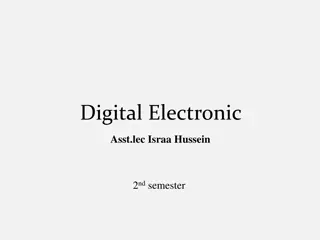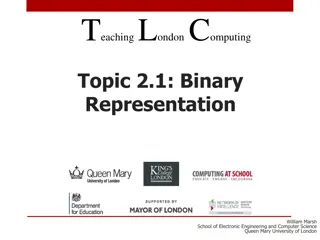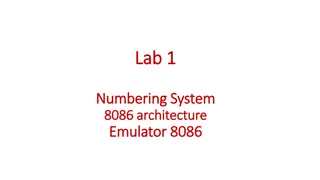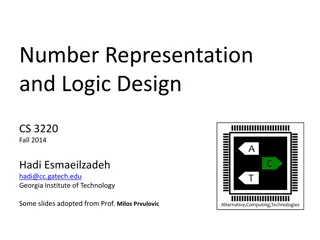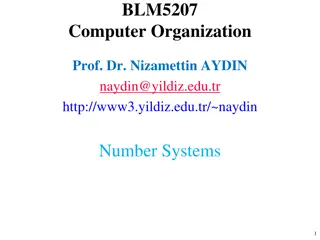Understanding Binary Representation in Computer Science
Delve into the world of binary representation with lectures on representing integers, fractional binary numbers, limitations of representable numbers, and floating-point representation. Explore exercises to hone your skills in translating fractional numbers between binary and decimal. Enhance your understanding of how computers interpret and store numerical data.
Uploaded on Apr 23, 2025 | 1 Views
Download Presentation

Please find below an Image/Link to download the presentation.
The content on the website is provided AS IS for your information and personal use only. It may not be sold, licensed, or shared on other websites without obtaining consent from the author.If you encounter any issues during the download, it is possible that the publisher has removed the file from their server.
You are allowed to download the files provided on this website for personal or commercial use, subject to the condition that they are used lawfully. All files are the property of their respective owners.
The content on the website is provided AS IS for your information and personal use only. It may not be sold, licensed, or shared on other websites without obtaining consent from the author.
E N D
Presentation Transcript
Lecture 4: Floats CS 105 Spring 2021
Representing Integers unsigned: 128 (27) 64 (26) 32 (25) 16 (24) 8 (23) 4 (22) 2 (21) 1 (20) signed (two's complement): -128 (27) 64 (26) 32 (25) 16 (24) 8 (23) 4 (22) 2 (21) 1 (20) Note: to compute x for a signed int x, flip all the bits, then add 1
Fractional binary numbers What is 1001.1012?
Fractional Binary Numbers 2i 2i-1 4 2 1 bi bi-1 b2 b1 b0 b-1 b-2 b-3 b-j 1/2 1/4 1/8 Representation Bits to right of binary point represent fractional powers of 2 Represents rational number: ?= ? 2-j ? (?? 2?)
Example: Fractional Binary Numbers What is 1001.1012? = ? + ? +? ?+? ?= ?? ?= ?.??? What is the binary representation of 13 9/16? 1101.1001
Exercise 1: Fractional Binary Numbers Translate the following fractional numbers to their binary representation 5 3/4 2 7/8 1 7/16 Translate the following fractional binary numbers to their decimal representation .011 .11 1.1
Exercise 1: Fractional Binary Numbers Translate the following fractional numbers to their binary representation 5 3/4 2 7/8 1 7/16 1.0111 101.11 10.111 Translate the following fractional binary numbers to their decimal representation .011 =? ?= .?? = ? +? ?= ?.? =? ?+? ?+? ?=? ?=? ?=? ?= .??? .11 1.1
Representable Numbers Limitation #1 Can only exactly represent numbers of the form x/2k Other rational numbers have repeating bit representations Value Representation 1/3 0.0101010101[01] 2 1/5 0.001100110011[0011] 2 1/10 0.0001100110011[0011] 2 Limitation #2 Just one setting of binary point within the w bits Limited range of numbers (very small values? very large?)
Floating Point Representation Numerical Form: 1? ? 2? Sign bit? determines whether number is negative or positive Significand? normally a fractional value in range [1.0,2.0) Exponent? weights value by power of two
Exercise 2: Floating Point Numbers For each of the following numbers, specify a binary fractional number M in [1.0,2.0) and a binary number E such that the number is equal to ? 2? 5 3/4 2 7/8 1 1/2 3/4
Exercise 2: Floating Point Numbers For each of the following numbers, specify a binary fractional number M in [1.0,2.0) and a binary number E such that the number is equal to ? 2? 5 3/4 2 7/8 1 1/2 3/4 M = 1.1 M = 1.0111 M = 1.0111 M = 1.1 E = 2 E = 1 E = 0 E = -1
Floating Point Representation Numerical Form: 1? ? 2? Sign bit? determines whether number is negative or positive Significand? normally a fractional value in range [1.0,2.0) Exponent? weights value by power of two Encoding: ? exp = ?? 1 ?1?0 frac = ?? 1 ?1?0 s is sign bit s exp field encodes ? (but is not equal to E) normally ? = ?? 1 ?1?0 (2? 1 1) frac field encodes M (but is not equal to M) normally ? = 1.?? 1 ?1?0 Float (32 bits): k = 8, n = 23 bias = 127 Double (64 bits) k=11, n = 52 bias = 1023 bias
Exercise 3: Floating Point Representations What are the values of s, exp, and frac that correspond to the float representation of 5 3/4, assuming 1-bit s, 3-bit exp, and 4-bit frac? 1? ? 2?, M = 1.0111, E = 2 s is sign bit s exp field encodes ? (but is not equal to E) normally ? = ?? 1 ?1?0 (2? 1 1) frac field encodes M (but is not equal to M) normally ? = 1.?? 1 ?1?0 Under those assumptions, what is the full representation of 5 3/4 as a one-byte floating point value? Assume big- endian order. ? exp = ?? 1 ?1?0 frac = ?? 1 ?1?0
Exercise 3: Floating Point Representations What are the values of s, exp, and frac that correspond to the float representation of 5 3/4, assuming 1-bit s, 3-bit exp, and 4-bit frac? 1? ? 2?, M = 1.0111, E = 2 s is sign bit s exp field encodes ? (but is not equal to E) normally ? = ?? 1 ?1?0 (2? 1 1) frac field encodes M (but is not equal to M) normally ? = 1.?? 1 ?1?0 Under those assumptions, what is the full representation of 5 3/4 as a one-byte floating point value? Assume big- endian order. 01010111 = 0x57 ? exp = ?? 1 ?1?0 frac = ?? 1 ?1?0 s = 0 exp = 101 frac = 0111
Example: Floats What fractional number is represented by the bytes 0x3ec00000? Assume big-endian order. ? exp = ?? 1 ?1?0 frac = ?? 1 ?1?0 s is sign bit s exp field encodes ? (but is not equal to E) normally ? = ?? 1 ?1?0 (2? 1 1) frac field encodes M (but is not equal to M) normally ? = 1.?? 1 ?1?0 Float (32 bits): k = 8, n = 23 bias = 127 1? ? 2? 0011 1110 1100 0000 0000 0000 0000 0000 s=0 s=0 exp=125 E = -2 frac = 100000000000000000000002 M = 1.100000000000000000000002 = 1.510 10 1.12 2 2= .0112=1 4+1 10 1.510 2 2= 1 3 2 1 4=3 8= .????? 8= .?????
Exercise 4: Floats What fractional number is represented by the bytes 0x423c0000? Assume big-endian order. ? exp = ?? 1 ?1?0 frac = ?? 1 ?1?0 s is sign bit s exp field encodes ? (but is not equal to E) normally ? = ?? 1 ?1?0 (2? 1 1) frac field encodes M (but is not equal to M) normally ? = 1.?? 1 ?1?0 Float (32 bits): k = 8, n = 23 bias = 127 1? ? 2? 0100 0010 0011 1100 0000 0000 0000 0000 s=0 s=0 exp=132 E = 5 frac = 011110000000000000000002 M = 1.011110000000000000000002 10 1.0111102 25= 101111.02== ????
s exp 1 frac 8-bits 23-bits Limitation so far What is the smallest non-negative number that can be represented? 0000 0000 0000 0000 0000 0000 0000 0000 s=0 s=0 exp=0 E = -127 frac = 000000000000000000000002 M = 1.000000000000000000000002 10 1.02 2 127= 2 127
Normalized and Denormalized s exp frac 1? ? 2? Normalized Values exp is neither all zeros nor all ones (normal case) exponent is defined as E = ?? 1 ?1?0 bias, where bias = 2? 1 1 (e.g., 127 for float or 1023 for double) significand is defined as ? = 1.?? 1?? 2 ?0 Denormalized Values exp is either all zeros or all ones if all zeros: E = 1 bias and ? = 0.?? 1?? 2 ?0 if all ones: infinity (if frac is all zeros) or NaN (if frac is non-zero)
Visualization: Floating Point Encodings + Normalized +Denorm +Normalized Denorm NaN NaN 0 +0
s exp 1 frac 8-bits 23-bits Exercise 5: Limits of Floats What is the difference between the largest (non-infinite) positive number that can be represented as a (normalized) float and the second-largest?
s exp 1 frac 8-bits 23-bits Exercise 5: Limits of Floats What is the difference between the largest (non-infinite) positive number that can be represented as a (normalized) float and the second-largest? 0111 1111 0111 1111 1111 1111 1111 1111 s=0 E = 127 M = 1.111111111111111111111112 largest = 1.111111111111111111111112 2127 second_largest = 1.111111111111111111111102 2127 diff = 0.000000000000000000000012 2127= 12 2127 23= ????
Correctness Example 1: Is (x + y) + z = x + (y + z)? Ints: Yes! Floats: (2^30 + -2^30) + 3.14 3.14 2^30 + (-2^30 + 3.14) 0.0
Floating Point in C C Guarantees Two Levels float single precision (32 bits) double double precision (64 bits) Conversions/Casting Casting between int, float, and double changes bit representation double/float int Truncates fractional part Like rounding toward zero Not defined when out of range or NaN: Generally sets to TMin int double Exact conversion, int float Will round
Exercise 6: Casting with Floats Assume you have three variables: an int x, a float f, and a double d. Assume that all three variables store numeric values (not + , , or NaN). Which of the following expressions are guaranteed to evaluate to True? 1. x == (int)(double)(x) 2. x == (int)(float)(x) 3. d == (double)(float) d 4. f == (float)(double) f
Exercise 6: Casting with Floats Assume you have three variables: an int x, a float f, and a double d. Assume that all three variables store numeric values (not + , , or NaN). Which of the following expressions are guaranteed to evaluate to True? 1. x == (int)(double)(x) 2. x == (int)(float)(x) 3. d == (double)(float) d 4. f == (float)(double) f True False False True
Floating Point Operations All of the bitwise and logical operations still work Float arithmetic operations done by separate hardware unit (FPU)
Exercise 7: Feedback 1. Rate how well you think this recorded lecture worked 1. Better than an in-person class 2. About as well as an in-person class 3. Less well than an in-person class, but you still learned something 4. Total waste of time, you didn't learn anything 2. How much time did you spend on this video lecture (including time spent on exercises)? 3. Are there particular questions you d like me to discuss in the problem session? 4. Do you have any other comments or feedback?
